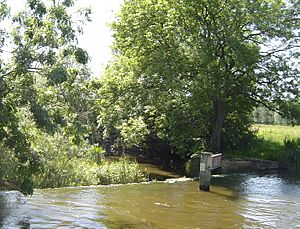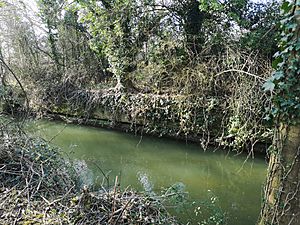Swift Ditch facts for kids
Quick facts for kids Swift Ditch |
|
|---|---|

Culham old bridge crossing the Swift Ditch just abouve its outflow to the Thames
|
|
| Details | |
| Location | Left bank of the River Thames |
| Opened | c. 1055 |
| Length | 2 kilometres (1.2 mi) |
| North end | Opposite Thrupp, half way between Nuneham Railway Bridge and Abingdon Lock |
| South end | Just below Culham Bridge |
The Swift Ditch is a waterway in England, about 2 kilometers (1.2 miles) long. It was built to create a shortcut for boats traveling on the River Thames. The Thames has many bends, called meanders. The Swift Ditch cuts across one of these large bends.
For a long time, this ditch was the main way for boats to travel to and from Oxford. It runs alongside the main river, creating an area of land called Andersey Island. This island is on the left bank of the Thames, across from Abingdon-on-Thames.
In 1632, a poet named John Taylor wrote about the ditch. He said that the main river near Abingdon was so shallow that the Swift Ditch was a much better path for boats. Even though some maps call it a 'Back Water', it usually has a strong flow of water.
Contents
History of the Swift Ditch
The Swift Ditch has a long and interesting history. It was created a very long time ago to help boats move more easily on the River Thames.
Building the Shortcut
Around the year 1052, a man named Ordric became the leader (Abbot) of Abingdon Abbey. At that time, the River Thames was the main way to transport goods between London and Oxford. However, people complained that the river near the Abbey was often blocked. This made it hard for boats to pass.
To fix this problem, Ordric ordered a new channel to be dug. This channel might have been an older, smaller one that they made bigger. The new channel started near a place called Thrupp. It then went through the fields of Andersey and flowed back into the Thames at Culham.
This new channel, the Swift Ditch, became the main route for boats for over 700 years! Imagine how many boats used it over all that time. Boats that used the ditch sometimes had to pay a toll. For example, during Lent, the toll for each boat was one hundred herrings.
Even before the ditch was made into a main route, monks had built a small stream, called a mill stream, from the area of the Swift Ditch to the Abbey. This was around the year 960 AD.
Changing Names and Importance
During the time of the Tudor kings and queens, the channel was known as Purden's Stream. But by the end of the Tudor period, people started calling it the Swift Ditch. It kept this name because it was still the faster way for boats to travel.
In the early 1600s, groups like the Oxford-Burcot Commission wanted to make the Swift Ditch even more important. Around 1636, one of the very first pound locks on the River Thames was built at the start of the Swift Ditch. Locks are like water elevators that help boats move between different water levels.
However, things changed again in 1788. People in Abingdon wanted boats to use the main river channel more. So, they built Abingdon Lock near the town. Within ten years, a new canal, the Wilts & Berks Canal, connected to the main river at Abingdon. This meant the Swift Ditch was no longer the most important route.
How the Swift Ditch Works Today
The Swift Ditch still flows today, even though it's not the main navigation route anymore.
Water Flow
Water from the Thames flows into the Swift Ditch in two places. One flow goes towards the remains of the old pound lock. The other flow goes over a small dam, called a weir. These two flows join together a short distance below the old lock.
In the middle of the ditch, there's a wider section. This might have been where an older type of lock, called a flash lock, was located. The banks of the ditch are covered with trees, and plants sometimes grow into the water.
Using the Ditch Today
Even though large boats don't use it much, the Swift Ditch is still used by canoeists. It's a peaceful place for paddling.
Bridges Over the Ditch
At the southern end of the Swift Ditch, where it meets the Thames again, there are three bridges.
- The original Culham Bridge was built in 1416. This was around the same time as the Abingdon Bridges were built over a shallow part of the river.
- A more modern bridge now carries the A415 road right next to the old Culham Bridge.
- Further downstream, a wooden footbridge allows people to walk across the ditch as part of the Thames Path.



